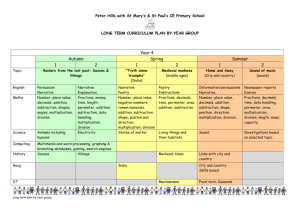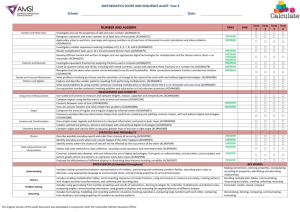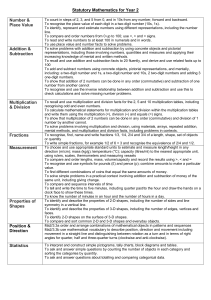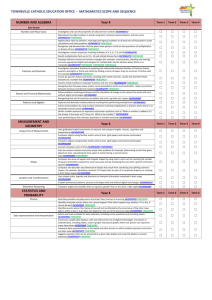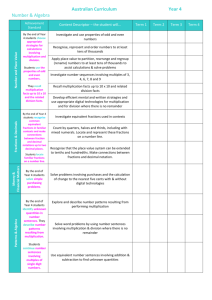Report Card Guidelines - Siuslaw School District
advertisement
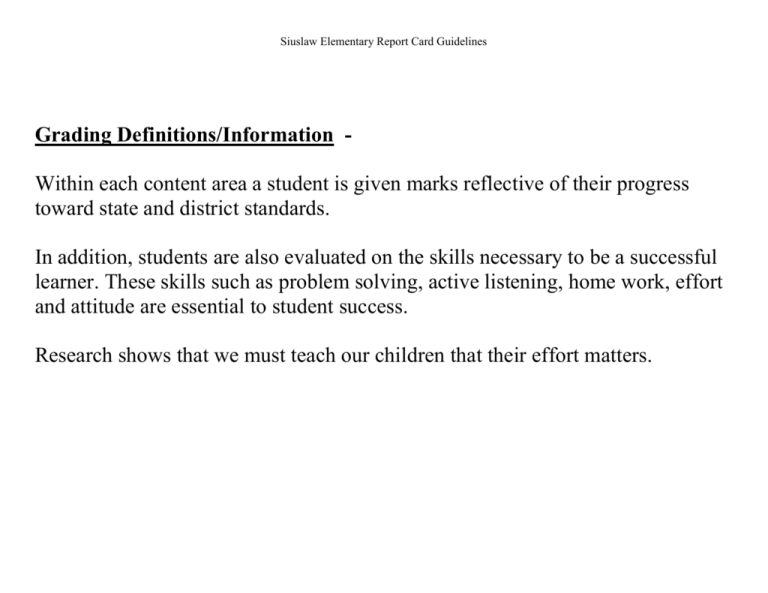
Siuslaw Elementary Report Card Guidelines
Grading Definitions/Information Within each content area a student is given marks reflective of their progress
toward state and district standards.
In addition, students are also evaluated on the skills necessary to be a successful
learner. These skills such as problem solving, active listening, home work, effort
and attitude are essential to student success.
Research shows that we must teach our children that their effort matters.
Siuslaw Elementary Report Card Guidelines
Grade 5 LA Standards
Reading Fluency
Read aloud grade level text with fluency and accuracy at a rate of 160
WPM
Vocabulary
Utilize context clues to discover word meaning.
Determine meaning by applying knowledge of word origins and word
relationships.
Comprehension
Follow multiple-step directions.
Identify the main events of the plot, their causes, and the influence of
specific events on future actions.
Draw conclusions or generalizations about text and support them with
textual evidence and prior knowledge.
Writing
Pre-write, draft, edit, revise, and publish with a focus on identifying
audience and purpose.
Write for different purposes and to a specific audience or person,
adjusting tone and style as appropriate.
Use quotation marks correctly in non-interrupted dialogue.
Write responses to literature showing an understanding of a literary
work.
Write research reports about ideas, issues, or events.
Conventions-punctuation/spelling/Grammar
Organization – paper is sequenced
Ideas & Content – clear topic with supporting details
Voice – Hear the reader in the writing
Sentence Fluency – variety of sentences
Word Choice – descriptive/colorful words
Speaking and Listening
Organize information to clarify and support spoken ideas with
evidence and examples.
Grade 5 Math Standards
5.1 Number and Operations and Data Analysis: Develop an understanding of and fluency with addition
and subtraction of fractions and decimals.
Use fraction models to represent the addition and subtraction of fractions with unlike denominators. Use
decimal models, place value, and number properties to add and subtract decimals (to the thousandths).
Select and use appropriate strategies to estimate fraction and decimal sums and differences.
Develop fluency with efficient procedures for adding and subtracting fractions and decimals and justify
why the procedures work.
Solve problems involving the addition and subtraction of fractions and decimals.
Use ordered pairs on coordinate graphs to specify locations and describe paths.
Construct and analyze double bar, line, and circle graphs to solve problems involving fractions and
decimals.
5.2 Number and Operations and Algebra: Develop an understanding of and fluency with division of
whole numbers.
Apply understanding of models for division (e.g., equal-sized groups, arrays, area models, equal intervals
on the number line) and the relationship of division to multiplication to solve problems.
Apply concepts of place value and the properties of operations to solve problems involving division
Select and use appropriate estimation strategies for division (e.g., use benchmarks, overestimate,
underestimate, round) to calculate mentally based on the problem situation when computing with whole
numbers
Develop and use accurate, efficient, and generalizable methods to find quotients for multi-digit division
problems.
Develop fluency with efficient procedures for dividing whole numbers and justify why the procedures
work on the basis of place value and number properties.
Determine the most appropriate form of the quotient and interpret the remainder in a problem situation
5.3 Geometry, Measurement, and Algebra: Describe and relate two-dimensional shapes to threedimensional shapes and analyze their properties, including volume and surface area.
Identify and classify triangles by their angles (acute, right, obtuse) and sides (scalene, isosceles,
equilateral).
Find and justify relationships among the formulas for the areas of triangles and parallelograms
Describe three-dimensional shapes (triangular and- rectangular prisms, cube, triangular- and squarebased pyramids, cylinder, cone, and sphere) by the number of edges, faces, and/or vertices as well as
types of faces.
Recognize volume as an attribute of three-dimensional space.
Determine volume by finding the total number of same-sized units of volume that fill a three-dimensional
shape without gaps or overlaps.
Recognize a cube that is one unit on an edge as the standard unit for measuring volume
Determine the appropriate units, strategies, and tools for solving problems that involve estimating or
measuring volume. Decompose three-dimensional shapes and find surface areas and volumes of
triangular and rectangular prisms.
Identify and measure necessary attributes of shapes to use area, surface area, and volume formulas to
solve problems (e.g., to find which of two gift boxes needs the most wrapping paper or has the greater
volume?).
Siuslaw Elementary Report Card Guidelines
Grade 4 LA Standards
Reading Fluency
Read aloud grade level text with fluency and accuracy at a rate of 140
WPM
Vocabulary
Use knowledge of root words to determine the meaning of unknown
words within a passage
Comprehension
Find information in specialized materials such as atlas, magazine, etc.
Identify and summarize key facts and information after reading two
passages or articles on the same topic
Use knowledge of a situation, setting, and character traits to determine
the causes for a character’s actions
Writing
Pre-write, draft, edit, revise, and publish with a focus on identifying
audience and purpose.
Write multi-paragraph compositions
Correctly spell homophones
Use correct subject/verb agreement
Write smoothly and legibly in cursive and manuscript
Read cursive handwriting
Conventions-punctuation/spelling/Grammar
Organization – paper is sequenced
Ideas & Content – clear topic with supporting details
Voice – Hear the reader in the writing
Sentence Fluency – variety of sentences
Word Choice – descriptive/colorful words
Speaking and Listening
Use appropriate grammar most of the time
Use volume, pitch, phrasing, pace, modulation, gestures, and eye
contact appropriately to enhance meaning and to engage the
audience
Grade 4 Math Standards
4.1 Number and Operations: Develop an understanding of decimals, including the connections between
fractions and decimals..
Extend the base-ten system to read, write, and represent decimal numbers (to the hundredths) between 0
and 1, between 1 and 2, etc
Use models to connect and compare equivalent fractions and decimals.
Determine decimal equivalents or approximations of common fractions.
Compare and order fractions and decimals.
Estimate decimal or fractional amounts in problem solving
Represent money amounts to $10.00 in dollars and cents, and apply to situations involving purchasing
ability and making change.
4.2 Number and Operations and Algebra: Develop fluency with multiplication facts and related division
facts, and with multi-digit whole number multiplication.
Apply with fluency multiplication facts to 10 times 10 and related division facts.
Apply understanding of models for multiplication (e.g., equal-sized groups, arrays, area models, equal
intervals on the number line), place value, and properties of operations (commutative, associative, and
distributive).
Select and use appropriate estimation strategies for multiplication (e.g., use benchmarks, overestimate,
underestimate, round) to calculate mentally based on the problem situation when computing with whole
numbers.
Develop and use accurate, efficient, and generalizable methods to multiply multi-digit whole numbers.
Develop fluency with efficient procedures for multiplying multi-digit whole numbers and justify why the
procedures work on the basis of place value and number properties
4.3 Measurement: Develop an understanding of area and determine the areas of two-dimensional shapes.
Recognize area as an attribute of two-dimensional regions
Determine area by finding the total number of same-sized units of area that cover a shape without gaps or
overlaps.
Recognize a square that is one unit on a side as the standard unit for measuring area.
Determine the appropriate units, strategies, and tools to solving problems that involve estimating or
measuring area
Connect area measure to the area model used to represent multiplication and use this to justify the
formula for area of a rectangle
Find the areas of complex shapes that can be subdivided into rectangles.
Solve problems involving perimeters and areas of rectangles and squares.
Recognize that rectangles with the same area can have different perimeters and that rectangles with the
same perimeter can have different areas.
Siuslaw Elementary Report Card Guidelines
Grade 3 LA Standards
Reading/Vocabulary
Read aloud grade level text at a rate of 120 wpm.
Use a dictionary or glossary to learn the meaning and other features of
unknown words.
Interpret information from diagrams, charts, and graphs.
Identify main idea and supporting details.
Literature
Differentiate among various genres. Summarize major points from
literary text.
Determine significant events from the story.
Writing
Prewrite, draft, edit, and revise using an age appropriate scoring guide;
publish with a focus on editing.
Create a single paragraph with topic sentence, simple supporting facts,
details, and concluding sentence.
Correctly spell high frequency words
Identify and correctly write singular possessive nouns.
Write legibly in cursive and manuscript.
Write narratives creating an understandable context and including
appropriate details.
Speaking and Listening
Demonstrate control of eye contact, speaking rate, volume, and
enunciation
Grade 3 Math Standards
3.1 Number and Operations: Develop an understanding of fractions and fraction equivalence.
Represent common fractions (e.g., halves, thirds, fourths, tenths) as equal parts of a whole, parts of a set,
or points or distances on a number line.
Recognize and demonstrate that sizes of fractional parts are relative to the size of the whole.
Use fractions to represent numbers that are equal to, less than, or greater than one.
Solve problems that involve comparing and ordering fractions by using models, benchmarks (0, ½, 1), or
common numerators or denominators.
Identify equivalent fractions using models, including the number line.
Add common fractions with like denominators.
3.2 Number and Operations, Algebra, and Data Analysis: Develop understandings of multiplication and
division, and strategies for basic multiplication facts and related division facts.
Represent and apply the concept of multiplication as repeated addition.
Represent and apply the concept of division as repeated subtraction and forming equal groups.
Apply models of multiplication (e.g., equal-sized groups, arrays, area models, equal 'jumps' on number
lines and hundreds charts) and division (e.g., repeated subtraction, partitioning, and sharing) to solve
problems.
Apply increasingly sophisticated strategies based on the number properties (e.g., place value,
commutative, associative, distributive, identity, and zero) to solve multiplication and division problems
involving basic facts.
Apply the inverse relationship between multiplication and division (e.g., 5 x 6 = 30, 30 ÷ 6 = 5) and the
relationship between multiples and factors.
Represent, analyze and extend number patterns using rules that involve multiplication and/or addition
(e.g., {3, 6, 9, 12, …}, {1, 2, 4, 8, …} ).
Analyze frequency tables, bar graphs, picture graphs, and line plots; and use them to solve problems
involving addition, subtraction, multiplication, and division.
3.3 Geometry and Measurement: Describe and analyze properties of two-dimensional shapes, including
perimeters.
Identify right angles in two-dimensional shapes and determine if angles are greater than or less than a
right angle (obtuse and acute).
Identify, describe, compare, analyze, and informally classify triangles by their sides and angles.
Identify, describe, compare, analyze, and classify quadrilaterals (square, rectangle, parallelogram,
rhombus, and trapezoid) by their sides and angles.
Identify, describe, and compare pentagons, hexagons, and octagons by the number of sides or angles.
Investigate and describe the results of decomposing, combining, and transforming polygons to make
other polygons.
Build, draw, and analyze two-dimensional shapes to understand attributes and properties of twodimensional space
Determine an appropriate unit, tool, or strategy to find the perimeter of polygons.
Use attributes and properties of two-dimensional shapes to solve problems including applications
involving parallel and perpendicular lines, congruence, symmetry, and perimeter.
Siuslaw Elementary Report Card Guidelines
Grade 2 LA Standards
Reading/Vocabulary
Read aloud grade-level text at a rate of 90 wpm.
Use context to identify simple, multiple-meaning
words(e.g., change, duck)
Determine meanings of word by using dictionary or
glossary.
Use titles, tables of contents, and chapter headings to
locate information in text.
Connect and compare information across selections.
Literature
Identify and describe plot, setting, and characters.
Writing
Pre-write, draft, edit, revise, and publish with a focus on
prewriting strategies.
Develop an idea with an introductory sentence,
supporting sentence, and concluding sentence.
Spell correctly words with short and long vowel sounds.
Capitalize the first word of a sentence and use correct
ending punctuation.
Form letters correctly and space words properly so
printing can be read easily by another person.
Write a letter with date, salutation, body, closing, and
signature.
Speaking and Listening
Tell experiences in logical order.
Grade 2 Math Standards
2.1 Number and Operations: Develop an understanding of the base-ten
numeration system and place-value concepts.
Write, compare, and order whole numbers to 1000.
Understand and apply base-ten numeration, and count in multiples of one, two, five, ten, and one hundred.
Compose and decompose whole numbers less than one thousand by place value (e.g., 426 as 4 hundreds +
2 tens + 6 ones and 400 + 20 + 6).
Use place value and properties of operations to find and use equivalent representations of numbers (such
as 35 represented by 35 ones, 3 tens and 5 ones, or 2 tens and 15 ones).
2.2 Number and Operations and Algebra: Develop fluency with addition facts
and related subtraction facts, and with multi-digit addition and subtraction.
Apply, with fluency, sums to 20 and related subtraction facts.
Solve multi-digit whole number problems by applying various meanings (e.g., taking away, and
comparing) and models (e.g., combining or separating sets, using number lines, and hundreds charts) of
addition and subtraction.
Develop fluency with efficient procedures for adding and subtracting multi-digit whole numbers and
understand why the procedures work on the basis of place value and number properties.
Select and apply efficient methods to estimate sums and differences or calculate them mentally depending
on the numbers and context involved.
Determine the value of mixed collections of coins to $1.00.
2.3 Measurement: Develop an understanding of linear measurement and
facility in measuring.
Determine length by finding the total number of equal-length units that are placed end-to-end without
gaps or overlaps.
Apply concepts of partitioning (the mental activity of slicing the length of an object into equal-sized units)
and transitivity (e.g., if object A is longer than object B and object B is longer than object C, then object
A is longer than object C).
Demonstrate an understanding that using different measurement units will result in different numerical
measurements for the same object.
Explain the need for equal length units and the use of standard units of measure.
Use rulers and other measurement tools to estimate and measure length in common units (e.g., centimeter
and inch).
Use the measurement process: choose an appropriate measurement unit, compare that unit to the object,
and report the number of units.
Demonstrate an understanding of time and use of time relationships (e.g., how many minutes in an hour,
days in a week, and months in a year).
Tell time in increments of five minutes using analog and digital clocks.
Siuslaw Elementary Report Card Guidelines
Grade 1 LA Standards
Reading/Vocabulary
Orally blend two to four spoken phonemes into
recognizable words.
Read aloud grade-level text at a rate of 40 wpm.
Classify categories of words according to meaning
(e.g. animals, food, toys).
Alphabetize a list of words by the first letter
Retell main events using beginning, middle and the
end
Literature
Make predictions based in illustrations and portions
of the story.
Grade 1 Math Standards
1.1 Number and Operations: Develop an understanding of whole
number relationships, including grouping in tens and ones.
Compare and order whole numbers to 100
Represent whole numbers on a number line, demonstrating an understanding of the sequential
order of the counting numbers and their relative magnitudes.
Count and group objects in tens and ones.
Identify the number of tens and ones in whole numbers between 10 and 100, especially
recognizing the numbers 10 to 19 as 1 group of ten and a particular number of ones.
Determine the value of collections of pennies, nickels, and dimes.
1.2 Number and Operations and Algebra: Develop understandings of
addition and subtraction and strategies for basic addition facts and
related subtraction facts.
Writing
With assistance, plan and compose first drafts using
some parts of the writing process such as planning,
drafting, rereading for meaning, and some selfcorrection
Write a complete sentence
Spell consonant-vowel-consonant words.
Print legibly and space letters, words, and sentences
appropriately.
Write brief stories that describe an experience
Speaking and Listening
Stay on topic when speaking.
Model 'part-whole,' 'adding to,' 'taking away from,' and 'comparing' situations to develop an
understanding of the meanings of addition and subtraction.
Develop and use efficient strategies for adding and subtracting whole numbers using a
variety of models, including discrete objects, length-based models (e.g., lengths of
connecting cubes) and number lines.
Apply with fluency sums to 10 and related subtraction facts.
Use the concept of commutative [4 + 2 = 2 + 4], associative [(4 + 3) + 7 = 4 + (3 + 7)], and
identity [0 + 3 = 3] properties of addition to solve problems involving basic facts.
Relate addition and subtraction as inverse operations.
Identify, create, extend, and supply a missing element in number patterns involving addition
or subtraction by a single-digit number.
1.3 Geometry: Compose and decompose two- and three-dimensional
geometric shapes.
Describe geometric attributes of shapes (e.g., round, corners, sides) to
determine how they are alike and different.
Recognize and create shapes that are congruent or have symmetry.
Compose and decompose shapes (e.g., cut a square into two right triangles
and put two cubes together to make a rectangular prism), thus building an
understanding of part-whole relationships as well as the properties of the
original and composite shapes.
Recognize shapes when viewed from different perspectives and orientations.
Siuslaw Elementary Report Card Guidelines
Kindergarten LA Standards
Reading/Vocabulary
Know letter names and sounds.
Blend consonant-vowel-consonant spelling patterns.
Locate the title and author of a book.
Literature
Answer simple questions about a story.
Writing
Write by moving hand from left to right and top to
bottom
Write upper and lower case letters of the alphabet
Speaking and Listening
Recite short poems and songs.
Kindergarten Math Standards
K.1 Number and Operations and Algebra: Represent, compare, and
order whole numbers, and join and separate sets.
Read and write whole numbers to 10.
Connect numbers, including written numerals, to the quantities they represent, using various
physical models and representations.
Count forward by ones beginning with any number less than 30; count backward by ones
beginning with any number 10 or less.
Recognize the number of objects in a small set (such as the arrangements of dots on a number
cube) without counting.
Count objects in a set using one-to-one correspondence and produce sets of given sizes.
Compare and order sets or numerals by using both cardinal and ordinal meanings.
Model simple joining and separating situations and represent them with objects, pictures,
and/or numerals.
Choose, combine, and apply effective strategies for solving joining and separating problems.
Identify, duplicate, and extend simple number patterns and sequential and growing patterns
(e.g.,patterns made with shapes).
K.2 Geometry: Describe shapes and space.
Identify, name, and describe basic two-dimensional shapes (e.g., square, circle, triangle,
rectangle, regular hexagon) presented in a variety of ways (e.g., with different sizes or
orientations).
Identify, name, and describe basic three-dimensional shapes (e.g., sphere, cube, and cylinder).
Use basic shapes and spatial reasoning to describe and model objects in their environment,
and to construct more complex shapes.
K.3 Measurement: Compare and order objects by attributes.
Identify the measurable attributes (e.g., length, weight) and non-measurable attributes
(e.g.,color) of an object.
Compare, sort, and order objects according to measurable (e.g., longest to shortest, lightest to
heaviest) and non-measurable (e.g., color, texture) attributes.
Compare the lengths of two objects both directly (by comparing them with each other) and
indirectly (by comparing both with a third object).
Siuslaw Elementary Report Card Guidelines
